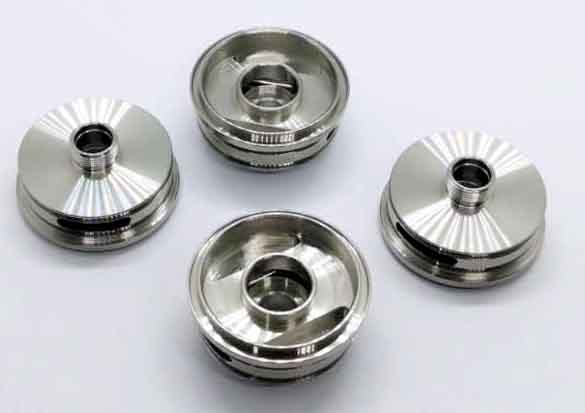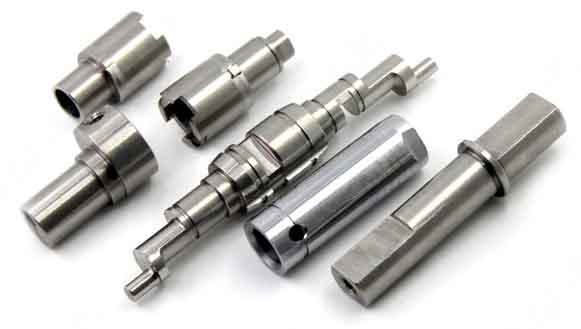Este artículo analiza la configuración del proceso para tornear acero endurecido., aleación de alta temperatura, aleación de titanio, hierro fundido enfriado, y piezas de material de pulverización térmica. Y las características de estos materiales difíciles de cortar, cantidades de corte, fluidos de torneado, y herramientas de torneado.
Tecnología de torneado de acero templado.
1. Turning of hardened steel:
① Cutting characteristics of hardened steel:
1) High hardness: HRC45-70.
2) High brittleness.
3) High strength: σb = 2100~2600 MPa, which is about 4 times that of 45 acero.
4) Large cutting force: The unit cutting force Kc is 4500MPa, cual es 2.5 times that of 45 acero.
5) Alta temperatura de corte: its thermal conductivity is 1/7 de 45 acero.

Tecnología de torneado de acero templado.
② Turning tool and cutting amount of hardened steel:
1) Tool materials: PCBN, cerámica, carburo cementado (600, 610, YS8, YT05, 758, 813), etc..
2) Tool geometry parameters: γ0=0~-10°, workpiece hardness and continuous cutting γ0=-10~-30°, α0=8~10°, kr=30~60°, λs=0~-3° .
3) Cutting amount: cemented carbide Vc=30~50m/min; Ceramic tool Vc=60~120m/min; PCBN tool Vc=100~200 m/min, Vc is 1/2 of the above during intermittent turning, and αp and f are 1/2 of general steel.
Note: Generalmente, the heat resistance of quenched steel is 200~400℃, and its hardness decreases with increasing temperature. The heat resistance of tool materials (hard alloys, cerámica, PCBN) are respectively 800~1000℃, 1200℃, 1400~1500℃, using this feature, in continuous cutting, Vc cannot be selected too low; When drilling, Vc should be reasonable, and the tool should be retracted; During continuous cutting, f should be small, κr should be appropriately reduced, γε increased, and λs should be negative.
Turning technology of superalloy

Turning technology of superalloy
2. Turning of superalloy
Because the high-temperature alloy contains many high melting point alloying elements Fe, De, Cr, En, V, W., Mo and so on. This element and other alloying elements form an austenitic alloy with high purity and dense structure. The contained elements and the non-metallic elements C, B, norte, etc.. form metal and non-metal compounds with high hardness, low specific gravity, and high melting point. Make other machinability very poor. Its relative turning workability is only 5-20% de 45 acero.
① Turning characteristics of superalloy:
1) Large cutting force: 2 a 3 times larger than cutting general steel.
2) Alta temperatura de corte: 50% higher than cutting 45 acero.
3) Severe work hardening: the hardness of the cutting surface and the machined surface is 50-100% higher than that of the matrix.
4) Tools are easy to wear: adhesión, diffusion, oxidación, and groove wear are easy to occur.
②Materials for turning tools of high-temperature alloys:
1) High-speed steel: High-speed steel containing high vanadium, high carbon and aluminum should be used.
2) Cemented carbide: fine and ultrafine particles of YG should be used
③ Geometric parameters of turning tools for high-temperature alloys:
Deformed superalloy: γ0=10°, cast superalloy: γ0=0°, generally do not take negative chamfering. α0=10~15°, rough turning λs =-10°, fine turning λs=0~3°, κr=45~75°.
④ Turning amount of superalloy:
1) High-speed steel cutter: Vc=3~8m/min.
2) Carbide tool: Vc=10~60 m/min. Deformed superalloy: Vc=40~60m/min. Casting high-temperature alloy: Vc=7~10m/min. αp and f>0.1milímetros.
⑤ Cutting fluid for high-temperature alloys: the same as stainless steel.
⑥ Drilling of high-temperature alloys: Carbide drills or S-type and shallow hole drills should be used as far as possible; Por ejemplo, when using a high-speed steel drill, increase the size of 2 wires, grind α0 and b, Vc is 3 m/min, and f is 0.2~0.3mm/r; The drill bit should be sharp, and the standard for bluntness is 1/2 a 1/3 of that of general steel. It is best to use automatic feed, do not stop on the cutting surface.

Tecnología de torneado de piezas de titanio.
Tecnología de torneado de piezas de titanio.
3. Turning of titanium alloy:
Titanium alloy is a new metal developed in recent decades. Because of its high specific strength (σb/ρ=1680/4.5=373, 4.5 times that of 45 acero), alta resistencia térmica (long-term work at 500℃), good corrosion resistance, and excellent low temperature performance, it is used in aerospace, chemical engineering , Medical treatment, etc..
① Cutting characteristics of titanium:
1) The cutting temperature of titanium is high: under the same cutting conditions, it is twice as high as cutting 45 acero.
2) Titanium has a great affinity and serious bonding, which will cause bonding at high temperatures.
3) Titanium has high chemical activity: under high temperature cutting conditions, it reacts with O, norte, h, C in the air to form a hard skin layer of TiO2, TiN, TiH, etc., which brings difficulties to cutting.
② Tool materials for turning titanium:
1) High-speed steel: In addition to ordinary high-speed steel, it is best to use high-vanadium, high-cobalt, and aluminum-containing high-speed steel.
2) Cemented carbide: YG8, YG6X, YG6A, 813, 643, YS27, YD15.3) PCD, PCBN natural diamond.
③ Tool geometry parameters: γ0=5~15°, α0≥15°.
④ Turning amount of titanium:
1) High-speed steel cutter: Vc=8~12 m/min.
2) Cemented carbide tools: Vc=15~60 m/min.
3) PCD, PCBN natural diamond tools: wet cutting Vc=200 m/min
Dry cutting Vc=100 m/min, αp>0.05milímetros, f>0.05mm/r.
⑤ Titanium cutting fluid: Emulsion and extreme pressure emulsion are used for one. Extreme pressure cutting oil is used for finishing.
⑥ Note for turning titanium:
When turning a slender shaft (rod), the live center and nylon should be used as the claw holder of the tool holder and the center frame; When reaming, use castor oil 60% + kerosene 40% as cutting fluid; Al tocar, appropriately increase the diameter of the bottom hole.
4. Turning of chilled cast iron:
The surface layer of the cast iron is white mouthed, and the hardness can reach about HRC60; The unit cutting force K c can reach 3000 MPa, cual es 1.5 times that of cutting 45 acero; The cutting force is concentrated near the cutting edge, and there are pores and sand in the machining, which can easily damage the tool during cutting;
Its brittleness is large, and the phenomenon of edge chipping and slag falling will occur during cutting.
① Tool material for turning cast iron:
1) Cemented carbide: a cemented carbide with high hardness and bending strength should be selected. Como: YS2, YS8, YS10, 600, 610, 726.
2) Ceramics: SG4, AT6, SM, FT80, FT85.
3) PCBN: used for fine turning.
② The geometric parameters of the tool for turning cast iron: 1) Carbide: γ0=0~-5°, α0=5~10°, κr≤45°(κr=45°), λs =-5~一10°, γε =0.5~1 mm;
③ The amount of cutting cast iron:
1) Carbide tool: rough machining Vc=7~10m/min, αp=5~10mm, f=0.5~1.5mm/r. Finishing: Vc=15~20m/min, αp=0.5~2mm, f=0.3~0.5mm/r.
2) Ceramic tools: Vc=40~50m/min, αp=0.5~2mm, f=0.3~0.6mm/r.
3) PCBN cutter: Vc=60~70m/min, αp=0.5~2mm, f=0.1~0.3mm/r.
5. Turning of thermal spraying (soldadura) materiales:
Thermal spraying materials are mostly multi-component high-strength alloys. After high temperature and high speed spraying on the surface of the workpiece, the hardness, resistencia a la corrosión, wear resistance and heat resistance of the surface of the workpiece are greatly improved, and it is widely used. The hardness of the copper-based and iron-based powder spray coating is easier to cut. The hardness of the cobalt-based and nickel-based powder spray coating is >HRC50, which is difficult to cut. Cobalt-clad WC, nickel-clad WC, and nickel-clad Al2O3 spray coatings have hardness> HRC65, which is the most difficult to cut.
① Tool materials for turning thermal spraying materials:
1) Cemented carbide: dureza>HRC45, using YG, YW cemented carbide;
Hardness, using 600, 610, 726, 767, YD05, YC12, YS2, YS8;
Hardness>HRC65, use YG3X, YD05, YC09, YC12, YS8, 600, 610.
2) Ceramic cutter: 3) PCBN
② The geometric parameters of the tool when turning thermal spray materials: γ0=0~-5°, α0=8~12°, κr≤45°.
③ The amount of cutting thermal spraying material: cemented carbide Vc=6~40m/min;
Ceramic cutter Vc=18~80m/min;
PCBN tool: Vc=24~160m/min. αp=0.15~0.6mm; f=0.1~1mm/r.
 English
English العربية
العربية 中文(漢字)
中文(漢字) Čeština
Čeština Dansk
Dansk Nederlands
Nederlands Suomi
Suomi Français
Français Deutsch
Deutsch Italiano
Italiano 日本語
日本語 ಕನ್ನಡ
ಕನ್ನಡ 한국어
한국어 Português
Português Русский
Русский Slovenčina
Slovenčina Español
Español Svenska
Svenska Türkçe
Türkçe

